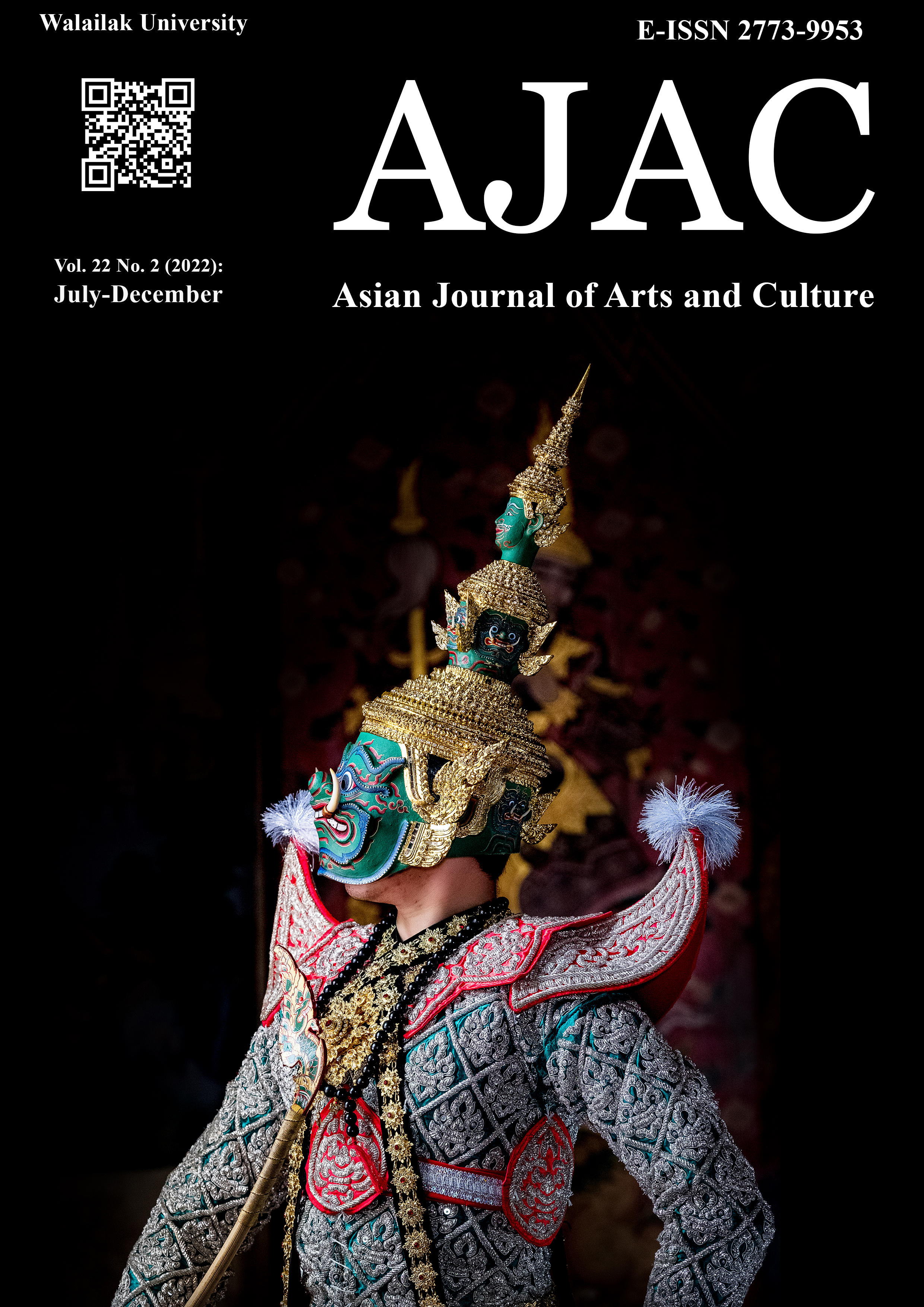Exploring Application Modes of Visual Arts: Naga Images of Thailand
Main Article Content
Abstract
Naga, the guardian of Triratna, rules over the waters, and is an important cultural image of Thailand, as well as an auspicious symbol in daily life. In Thailand, there is a large and subtle Naga cultural heritage that includes folk literature and festivals. Whether it is an old tradition or a new cultural creation, many cultural heritages based on the Naga theme merge in contemporary visual art, and spread the images and beliefs of Naga through the Internet, sculptures, murals, emoticons, animations, festivals, amulets, fabrics, and artworks. This article aims to use Naga images for analyzing the application mode of Naga in the visual arts of Thailand. Research results show: (a) the design expressions of Naga arts are diverse in terms of the application mode of Naga in visual arts, including the interaction of technology, art, and the cultural and creative industries; and (b) Naga images have become a part of the cultural industry. Moreover, the cultural meaning of the Naga images has changed and is different from its previous religious connotations.
Article Details

This work is licensed under a Creative Commons Attribution-NonCommercial-NoDerivatives 4.0 International License.
© 2018 by Asian Journal of Arts and Culture, Walailak University. All rights reserved.
References
Bovornkitti, L. (2005). The Influence of Buddhism in Historical Thai Art. Journal of the Royal Institute of Thailand, 30(2), 355-362.
Chang, Y. L. (2017). Exploring Naga Images: Textual Analysis of Thailand’s Narratives. Jounal of Mekong Societies, 13(1), 19-35.
Davis, R. B. (1984). Muang Metaphysics. Bangkok, Thailand: Pandora.
Deetes, T. (2003). Proceedings of Local Wisdom and Culture of Thailand. Bangkok: Office of the National Culture Commission.
Jumsai, S. (1997). NAGA: Cultural Origins in Siam and the West Pacific. Bangkok, Thailand: Chalermnit Press.
Karnjanatawe, K. (2016). Mekong River Landmark. Retrieved from https://www.bangkokpost.com/travel/
/mekong-river-landmark.
Laomanajarern, S. (2003). Naga: A Symbol Study Related the Indian Model. Journal of Damrong, 2(4), 148-158.
Ngaosrivathana, Mayoury, and Pheuiphanh Ngaosrivathana. (2009). The Enduring Sacred Landscape of the Naga. Chiang Mai, Thailand: Mekong Press.
Nimlek, S. (2014). Animals in architectures of Thailand. Bangkok: Matichon Press.
Nu, W. (2016). Worawit Nu Photo Book. Retrieved from https://www.facebook.com/worawitt.nu.
Panda, S., S. (2004). Nagas in the Sculptural Decorations of Early West Orissan Temples. Ohrj, 48 (1), 16-37.
Phan, A. (2016). The Signification of Naga in Thai Architectural and Sculptural Ornaments. DIALOGUE, 17(4), 154-175.
Phlainoi, S. (2009). Animals of Himmapan. (4th ed.). Bangkok Thailand: Phimkham.
Phra Brahmagunabhorn. (2014). The Realm of the Four Great Kings inDictionary of Buddhism. (24th ed.) Bangkok, Thailand: Sahathamik.
Prajonsant, S. (2006). Suea-dam, Tam-phrae, Sin-mai: A Database of Local Wisdom. Journal of Mekong Societies, 2 (2), 125-138.
Sanboon, T. (2010). Identity in the Decorations of Local Religious Constructions of the Isaan Region of Thailand and Lao PDR. Academic
Journal : Faculty of Architecture, Khon Kaen University, 9(1), 45-60.
Tambiah, S.J. (1970). Buddhism and the Spirit Cults in North-East Thailand. London, UK: Cambridge University Press.
Thai Youth Encyclopedia Project. (2012). Local Wisdom in Thailand. Bangkok, Thailand: Thai Youth Encyclopedia Project by His Majesty the King.
The Department of Cultural Promotion. (2016). Preservation and Protection of Intangible Cultural Heritage Act 2016. Retrieved from http://ich.culture.go.th.
The National Museum Bangkok. date unknown. “Dvaravati.” Retrieved from http://www.virtualmuseum.
finearts.go.th/bangkoknationalmuseums/index.php/en/exhibitions/model-present.html.
Wongthes, S. (2003). Naga in History of Southeast Asia. Bangkok, Thailand: Mati Cho.
Yen, C. H. (2005). The sculptures of Dvaravati: The pioneer of Theravada Buddhism in Southeast Asia. Taiwan Journal of Southeast Asia Studies, 2(1), 3-68.


